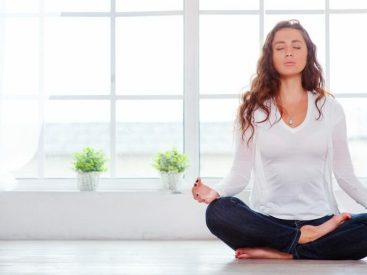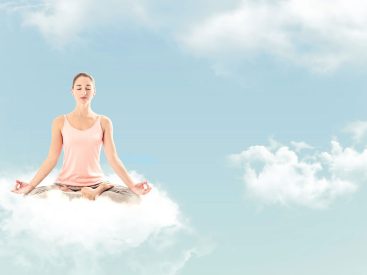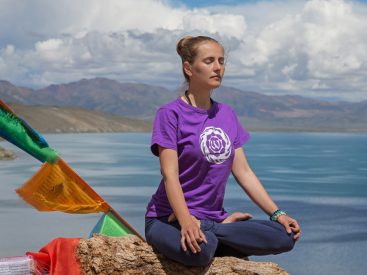The Yogi knows that the path of sense gratification is wide, but it leads to destruction, and many follow it.
MUdre Patanjali described in his work “Yoga Sutras” eight steps of the classical path of the yogi.
These include Yama, Niyama, Asana, Pranayama, Pratyahara, Dharana, Dhyana, Samadhi , and this path is called Raja Yoga (the path of meditation, cognition of the inner world of a person).
If a person does not follow principles in his life Yamas and Niyamas (ethical and moral aspects), his mind will not be able to calm his worries, and thoughts will tend to external phenomena.
Mastering Asan, or postures of the physical body, is necessary to get rid of physical ailments and learn to stay in a stable meditative posture for a long time.
Breathing practices (Pranayama) soothe chaotic thought formation and allow you to achieve control over thinking in a natural way.
These four stages are called external. When mastering them, the practitioner gets the opportunity to move further – to the four inner steps.
The first step of the “inner” yogic path is Pratyahara.
Pratyahara – ( Skt. pratyahara – discarding, avoiding a specific object of thought, abstraction) – the practice of controlling the senses, through which they do not come into contact with their objects and follow the nature of the mind.
Vladimir Antonov in his book “Human Ecology” says: “Pratyahara is the stage at which the adept learns to control the” tentacles “of consciousness (indriyas).”
What is such control for?
We hardly live in the present. The human mind is constantly rushing about, being attached to what is not at the moment (memories, fantasies …).
Swami Vivekananda compared the mind to a raging drunk monkey, in addition to being bitten by a scorpion: “The initially restless mind rages when it is drunk with the wine of desire. He falls into pride when he is stung by the scorpion of jealousy for the success of others. “
It interferes with the realization of true goals. – what makes us truly happy and free. In addition, in the modern rhythm of life, we unconsciously read a lot of unnecessary information. It accumulates in the subconscious and gradually fills the consciousness, and the mind processes it. This uncontrollable mental noise makes it difficult for us to notice what is happening in real time. But we cannot be isolated from what is happening around us. Yes, it is not required.
It is necessary to control the state of mind and the senses that react to the information received. It is necessary to learn to keep the real I with real goals and values among the endless information “rubbish”.
The mind is by nature conscious, pure, and free from hesitation.
However, the senses tend to strive to satisfy their corresponding sense objects (eyes – to enjoy the color, ear – to enjoy the sound, etc.). In the process of this striving, consciousness expands outward and assimilates to these objects, becoming their “hostage”.
But at the same time, the mind seeks to return to its natural state. From such dissonance, a person experiences constant suffering.
Pratyahara is designed to stop the opposition of the senses and take them under the volitional control of consciousness.
This practice trains the non-connection of thoughts with the objects of their sphere and the abstraction of the senses from their sensibility. This allows you to release a mass of psychic energy and direct it to higher goals.
“As a turtle draws its limbs inside its shell, so the yogi must eliminate the feelings within itself.” Goraksha Paddhati.
As mentioned above, external stimuli, acting on the senses, reach consciousness as impressions, thereby creating samskaras, and, no less important, distract attention.
In this regard, undoubtedly, you need to learn to control your perception, which is very difficult, but, as the experience of the sages shows, it is quite possible.
Some masters recommend first learning to perceive the sensations emanating from any one sense organ, trying not to perceive others, and suggest certain exercises for this. For example, for sight – daily examination of an object for a certain time, for hearing – listening to any one sound (for example, the ticking of a clock), for touch – concentration on a physical sensation at any point in the body. Also tasteful and smelling.
Having achieved success in the practice of these exercises separately, you can combine them and learn to distinguish one from the mass of impressions, without perceiving it. For example, looking at the clock, not to hear its ticking, and vice versa – listening to the ticking of the clock, not to see it. They do the same with other sensations.
Having gained experience in all these exercises, it will not be difficult to focus on the object actively or passively, or completely turn off attention.
Some yoga teachers consider pratyahara to be a phenomenon achieved by pranayama, and recommend increasing the intensity and duration of pranayama, especially delays, until a person becomes “blind, deaf, non-smelling, not feeling like a lump.”
In the Yoga Sutras of Patanjali there is no direct indication of how exactly one should practice pratyahara.
Verse 52 says that thanks to pranayama, obstacles to the Light are destroyed.
The 53rd stanza is a continuation of the 52nd “… and the suitability of manas for concentration.” It is the suitability of Manas for concentration that makes it possible to “gather inside” the sense organs. In the absence of communication with the external world, the sense organs “seem to follow the internal form of consciousness” – this is the definition of pratyahara from stanza 54. The next stanza simply adds that this is the way to achieve complete control over the indriyas.
Hence, we can conclude that the main method of subordinating the senses, according to the Yoga Sutras, is a long-term unidirectional concentration of consciousness on one point, as a result of which the senses are disconnected from external objects.
It is my personal experience that the practice of concentrating on one point is very effective.
Having devoted 20-30 minutes a day to her for the last three months, I felt how much more balanced I had become. It has become much easier to “filter” the information coming from outside, to track the emerging emotional reactions and control their external manifestation. This allows you to live every day as efficiently as possible without wasting energy.
But the practice of pranayama is no less important as a preparation for pratyahara: while doing pranayama, the practitioner, as it were, releases the light of knowledge hidden by impurities. From this, the fitness of the mind for concentration increases, and it becomes possible to hold attention inside.
In addition, in the early stages of practice, it takes a lot of energy to divert the attention of the senses from external objects and collect them in a single point. And, as you know, pranayama is one of the best methods of energy storage. That is why the stage of pranayama as a powerful energy practice should also precede the stage of pratyahara.
There is also such a thing as the sensory deprivation chamber (floating capsule), invented by John Lilly in 1954.
At first glance, it may seem that its function is aimed at achieving the state of pratyahara.
However, having studied in more detail the history of its creation and the principles of its work, we can say with confidence that this is not so. This method allows you to quickly restore the body, relieve stress, bring a person into a cheerful state, but nothing more.
Lilly himself, in the course of his research, came to the conclusion that the human brain is capable of generating internal experiences completely independently of the external world. Thus, the absence of stimuli does not “block” his activity. In conditions of isolation, the mind switches from “everyday” tasks to constructing new experiences from accumulated impressions and memories, introspection and building new projections.
Thus, the use of such devices can be considered nothing more than “crutches” in practice or entertainment, which can turn into addiction at any moment.
By his own efforts, the yogi achieves the best result, because he does not need auxiliary “structures”. He can perfectly isolate his psyche, surpassing the outside world. Indeed, in fact, pratyahara is a step towards freedom from enslavement by matter.
Having mastered pratyahara, one can, at will, connect or disconnect the mind with the senses. Physical pain, cold and heat, hunger and thirst no longer have power over the yogi who has mastered this stage.
“A yogi who is firmly established in pratyahara can calmly meditate even on the battlefield, accompanied by the continuous rumble of countless weapons.” S. Sivananda.
In general, it is believed that success in pratyahara, as in other yogic practices, depends on the depth and strength of the experience of the past. lives. So the Yoga Path is more a memory than a study from scratch. Therefore, there cannot be a single methodology for all people, since there are no two people with exactly the same experience.
Unfortunately, it has already happened more than once that practitioners, making excessive efforts to become independent from the outside world, received the completely opposite result: instead of renouncing, they fell into the trap of even greater attachment.
The point is that disconnecting from external factors does not mean focusing on internal problems and conflicts.
And it turns out that a person, with great difficulty pulling himself out of the swamp of addictions, enters it from the other side, believing that this time he has chosen the right path.
Sai Baba’s disciple, seeing a beautiful woman, was frightened. To which the Teacher said to him: “The natural inclinations of a person should never be hindered. Since there is no trouble in following them. Brahmadev created this universe, and if we do not appreciate his creations, then all His ingenuity and skill will be wasted. Gradually, over time, everything will fall into place. If you are standing in front of a door wide open, then why break into a closed door? If the mind is pure, no difficulty is expected. If you are not besieged by bad thoughts, why be afraid? “
“Since the mind is inherently unstable, one should not give it free rein. The senses can follow their objects, but the body must be in control. We should not obey the senses and feel lust for the objects of the senses. By constantly and gradually educating ourselves, we will cope with the anxiety of the mind. Feelings cannot be completely controlled, but at the same time, we must not be allowed to overwhelm us. We should restrain them, in the right and proper way, depending on the circumstances. Beauty is the object of sight, we must calmly contemplate the beauty of the environment. There is nothing to be afraid or ashamed of here. One should only protect the mind from bad thoughts. Contemplate the creation of the Lord with a pure mind. Then it will be easy and simple to control the senses, and even while enjoying the sense objects, you will remember God. If you do not control the senses and allow the mind to rush to their objects and become attached to them, you will not get out of the cycle of birth and death. Even the slightest desire for sense gratification destroys spiritual joy. “(Sri Sai Satcharitra. Sai Baba).
Thus, Pratyahara is necessary for achieving stability of consciousness.
By bringing awareness to our lives, we learn to “be present,” to be here and now.
If we focus with all our feelings and attention on the current business, then we will be able to cope with the task as efficiently as possible, and we will become more and more holistic and harmonious from time to time.
And, as B.K.S.Iyengar said, having lost the greed for sensual things, a person will treat defeat and victory in the same way. Such a person does not despise anything and directs everything on the path of perfection.
But, while practicing, it is important to maintain a balance between facing the outside world (the world of external objects that distract consciousness) and the inner world (the world that is immersed in psychic visions).
Get better and change the world for the better.
Ohm!


